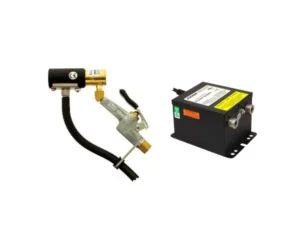The control of static charge build-up is important in many industrial and manufacturing systems. Static can cause a sparking risk in explosive environments or can cause loose product or dust to become stuck to surfaces making them harder to clean. So methods of removing static are required in many environments.
The basic operating principle of the static control products offered by ANP is as follows:
A high voltage (7Kw) AC current is used to ionise air. As the current alternates, it created positive ions on one part of the AC cycle and negative ions on the other. This ionised air is then directed at the target surface by either a blower or by combining the ioniser with an air knife or other air nozzles.
If the target is positively charged then the negative ions will interact with it can neutralise the charge. The positive ions in the air flow will be repelled back to the atmosphere. If the target is negatively charged the positive ions will interact and neutralise the static. In this way, both positive can negatively charged surfaces will be neutralised.
As the ions are mixed there is always a danger that they will recombine and neutralise each other before they get to the target. This limits the range of static control blowers, however, when combined with air knives the range can be increased because these air nozzles deliver a far more laminar flow of air. This means the ionised air flow mixes around less and so recombination is less likely. This is why air ionisers combined with air knife technology is so popular.
EXAIR industrial Static Eliminators combine engineered airflow products with ionisers which give the products the ability to eliminate static charges quickly and from long distances. Prevent dust from clinging to products, materials jamming or tearing, sheet feeding woes, and hazardous shocks by neutralizing static with our eliminators. Perfect for webs, sheet stock, three dimensional parts, extrusion, packaging and much more!
The range includes:
Standard Ion Air Knves
Super Ion Air Knives
Ionising bars
Ion Air Wipes
Ion Air Cannons
Ion Air Guns
Ion Air Nozzles
Benchtop Ionizer
Ion Air Jet
Static Eliminator Accessories


